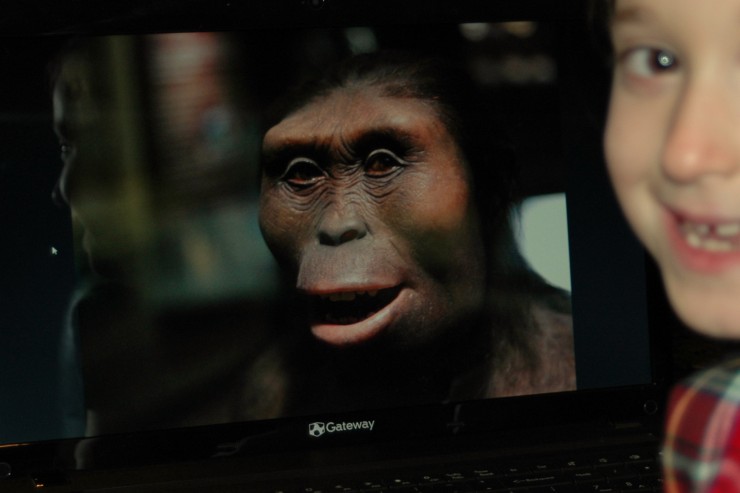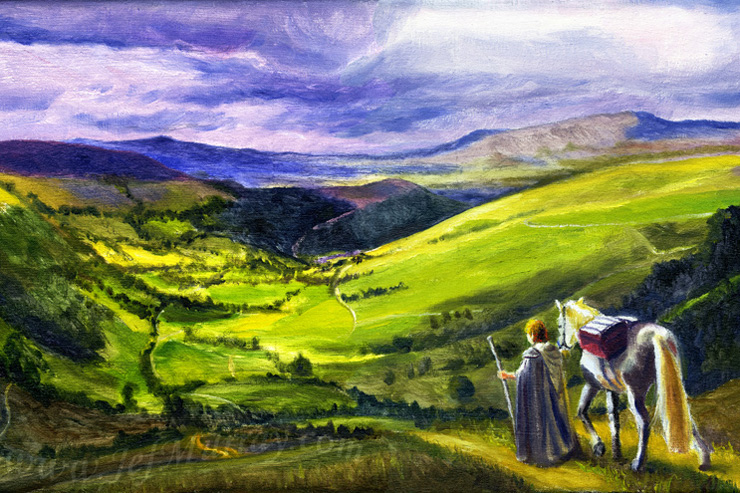In elementary school, children learn about dinosaurs and fossils, how fossils form, how paleontologists reconstruct skeletons of animals from the past using those fossils. There seems no difficulty whatsoever accepting that all kinds of plants and animals lived on the Earth before people lived.
Meanwhile, the Catholic children learn about Creation, Adam and Eve, Original Sin, Noah’s Ark, and the birth, life, death, and resurrection of Our Lord Jesus Christ. These teachings become the foundation of hope, faith, and love throughout the Sacramental life, journeying toward Heaven.
As a Catholic convert, I had no problem accepting evolutionary theory until I thought about its implications on the biblical account. What about the dinosaurs? How can one species become another? When I realized evolutionary theory meant we descended from ape-like creatures and even single cells, I could not see how Genesis could be taken literally.
Hence I was hesitant to say I accepted the science because I was afraid it would mean rejecting my faith. I tried to dismiss evolution as “only a theory,” but I knew better. I had studied biochemistry and was aware of the nuts and bolts of the evolutionary process at the genetic and molecular level. Plants and animals are different kinds of living things, but both reproduce via genetic material made of the same isomeric forms of 20 different amino acids that build all the proteins for life. Heredity is passed on through this genetic material. The entire taxonomic hierarchy of living things relies on this reproductive mechanism. To reject evolution is to reject the foundation of the biological sciences.
Suspecting I was not the only one struggling with this question, I recently asked my friends what questions they most struggled with. Here are only five. (There were many more.) I struggled with them too.
Faith and Science Can Co-Exist?
In America we are told by everyone that faith and science can’t co-exist. Secularists believe it, public scientists believe it, and even most popular preachers believe it. I had an intense interest in biology as a young boy but was told that a Christian couldn’t be a biologist.
In a letter to Reverend George Coyne, S.J., then the director of the Vatican Observatory, Pope St. John Paul II wrote an often quoted summary of the relationship between faith and science. “Science can purify religion from error and superstition; religion can purify science from idolatry and false absolutes. Each can draw the other into a wider world, a world in which both can flourish.”
It is sad that children are told that faith and science cannot co-exist because it robs children of knowing the “wider world” in which both can flourish. It robs them of knowing how to avoid both superstition and idolatry. The solution for Catholic parents is simple—teach your kids God made everything. Children are naturally awed by nature, the sun, the insects, the trees, the snow, the canyons and the mountains. If you tell them that God made it all, their fascination will be fueled. Nature is a reliable, orderly, amazing creation, and the Christian world view is rational, sane, and necessary for science. Remembering that God made everything is the key to understanding the relationship between faith and science. To learn any science is to learn about God’s creation. There can never be any real conflict, only incomplete understanding on our part.
As it relates to evolution, the Christian believer does not view God as a cause among other causes, but as The Cause, always present and working in the world. He is existence itself, the reason for everything. However the diversity of life happened, the entire course of evolution depends on God for its beginning and every activity along the way. Science studies the secondary, observable causes in the physical realm, but we believe those causes are guided by the faithful hand of God.
Only a Theory?
This is probably the most often repeated dismissal of evolution. Of course, evolution is a theory, but theories are legitimate scientific concepts. Theories are explanatory. The scientific method generates hypotheses, and once a hypothesis is confirmed by repeated and varied testing, it is raised to a theory. So a theory is a well-tested explanation for a broad set of observations. Kinetic theory, for example, provides the basis for the Ideal Gas Laws. It helps the scientist form mental pictures and predict behaviors.
Evolutionary theory also helps scientists form mental pictures to explain how the diversity of living things might have happened over time. It explains what caused the changes we observe. Natural selection and genetic drift are explanations for these changes, and genetic studies have provided an explanation of the mechanism of evolution at the molecular level. Is there more to it? Of course there may be more explanations with further study.
Evolution is also a fact, or a law. Scientific laws are concise statements that summarize results. The relationship between the pressure of a gas in a sealed container and volume of that gas at a constant temperature is Boyle’s Law, named after Robert Boyle who first reported the law in a systematic way. It is not explanatory. It is a statement of fact. Evolution is a fact in that it is a measure of the genetic changes that occur with time in a population. Scientists know these changes occur. They can observe them, quantify them, and in some cases, predict them.
Death and Dinosaurs?
If death did not enter the world until the Fall, then what about the dinosaurs? That suggests there was death and carnivorous behavior during pre-human times.
In Romans 5:12, St. Paul the Apostle said: “By one man sin entered into the world, and by sin death, and so death passed upon all men, in whom all have sinned.” In the decree on Original Sin, the Council of Trent taught that the first man, Adam, transgressed the commandment of God in Paradise and immediately lost his holiness. In doing so, “he incurred through the offense of that prevarication the wrath and indignation of God and hence the death with which God had previously threatened him.” (Denzinger, 788).
Those last words, “hence the death…God…threatened,” are important, as is the distinction of “all men” in St. Paul’s letter. Adam’s sin, as threatened, transmitted death to mankind, but not to animals. Death is natural for animals. It is how they were created. For man, death is also natural, but God created man for everlasting life through grace. Ludwig Ott explains in Fundamentals of Catholic Dogma on “The Origin of Death” that man was “endowed with the preternatural gift of bodily immortality in Paradise.” (p. 473) As warned, the gift was lost as a punishment for sin.
Ott also explained that in the case of those justified by grace, death loses its penal character. Our Lord Jesus Christ and His Mother Mary were free from Original Sin. Death was neither a consequence nor a punishment for them, but death was natural for their human nature. Other animals die as well because it is natural for them. They were not created with the preternatural gift of immortality. They were not given free will. They did not sin against God. By nature, they die and always have.
Microevolution and Macroevolution?
I have no trouble with micro-evolution (among species), but I don’t see how macro-evolution (one species arising from another) can occur.
Evolution happens because of changes in gene frequencies over time. “Gene frequency” refers to how often a particular gene (i.e. deoxyribonucleic acid, DNA, sequence for a specific trait) appears in a population. Researchers can determine gene frequency using DNA sequencing techniques.
Suppose a scientist discovers three genes and calls them gene A, gene B, and gene C. Then she collects DNA from individuals of a population and finds that half of them have gene A, a quarter of them have gene B, and the last quarter has gene C. She has determined that the gene frequency is 50, 25, and 25 percent respectively. If she repeats this study over successive generations and finds that the frequency changes to 30, 30, and 40 percent, then evolution has occurred by the processes of “genetic drift.”
Gene frequencies can remain constant for long periods of time, or they can change quickly in response to changes in the environment. Suppose the environment was depleted of a certain food that individuals with gene A needed to live long enough to reach the age for reproduction. Those individuals would not reproduce at the same rate as the others, and the frequency of gene A would decrease. In this case, genetic drift would have occurred because of “natural selection.”
The process is the same on both short or long time scales. Microevolution refers to the evolutionary process over short times and small changes. An example is a bacterium population in a laboratory where a mutation occurs that creates a gene that causes the individual bacteria to divide more rapidly. Macroevolution refers to the evolutionary process over a long time and larger changes. Over longer times, more gene frequencies change, sometimes enough for speciation to occur and for one species gives rise to two. Is there more to the story? Probably. The structure of DNA was not known in Charles Darwin’s time, but later the theory was expanded with knowledge of genetics. We do not know what will be discovered next, and there are plenty of studies probing other hypotheses far beyond the scope of these short answers.
Descended from Apes?
Are we supposed to accept that humans evolved from apes?
Paleoanthropology tells the story like this: Human evolution began in Africa about 4 million years ago. Humans appear to have evolved from ape-like creatures (not apes) that evolved from creatures before them. Our branch of the tree of life includes the apes, the chimpanzees, and us—evolutionary cousins. The evidence is in the DNA, which is like a molecular clock in that the number of chemical differences (amino acids) in proteins between different lineages changes roughly linearly with time (i.e. proportionally). By comparing the genomes of chimps with the human genome, and by comparing that data set with the rate specific genetic substitutions that are known to occur, it seems that about 5 million to 7 million years ago chimps diverged on one lineage and humans on another.
The evidence is also in the fossil record. Fossils have been found for a large number of hominid species. They are described on the Smithsonian National Museum of Natural History website. Just because the Smithsonian presents the claim certainly does not make evolution true, but it does give weight to the notion that these are the serious and real findings of scientific discovery.
In 2013, the Pontifical Academy of Sciences invited Dr. Yves Coppens to present a paper on “Hominid Evolution and the Emergence of the Genus Homo.” Dr. Coppens is the anthropologist who was the director of the Hadar expedition in 1974 that discovered the AL 288-1, several hundred pieces of bone comprising about 40% of the skeleton of a Australopithecus afarensis in Ethiopia popularly known as “Lucy.”
In his presentation, he recounted the evidence for early prehumans, classic prehumans, late prehumans, early humans, classic humans, and late humans, and traced how each lineage evolved to their environment and spread out across larger and larger territory, all becoming extinct except the population of Homo sapiens sapiens who moved to Europe 50,000 years ago and spread throughout the world, some of them still living among other members of the genus Homo who had not yet gone extinct. Since 10,000 years ago, there has only been one species and one subspecies, and that is our own.
Professor Coppens was named an Ordinary Member of the Pontifical Academy of Sciences by Pope Francis in 2014. This scientific knowledge about the evolution of man helps to better understand who we are. Catholics have assurance that it is at least acceptable to consider what evolutionary science has to say about our descent.
Always Developing…
If you read what I write regularly (and thank you if you do), then you are probably tired of me repeating this, but it cannot be repeated enough. Science and theology are never complete. Scientists probe into the physical world to understand its mysteries. Theologians seek to understand faith and Divine Revelation. But because we are human, we are never, not individually or collectively, going to find all the answers.
Therefore, when you sit down and try to wrap your head around this evolution business, keep that in mind. Do not read scientific ideas as complete. Read them as developing, subject to error, subject to correction. Realize too that theologians need time for their scholarship to develop, especially as they consider scientific discoveries in the light of faith. Scholarship is slow going, but over time the truth will sift out.
Recommended Reading
Fr. Paulinus F. Forsthoefel, S.J., Religious Faith Meets Modern Science, Alba House (1994). This is an easy to read, short book written by a Catholic priest who was a geneticist and college professor. I highly recommend it for young adults who are studying biology in high school or college.
Greg Krukonis and Tracy Barr, Evolution for Dummies, Wiley Publishing, Inc. (2008). Seriously, do not let the title fool you. These books are well-written summaries, meant to accompany a textbook or to be read alone. They also cost much less than a textbook.
Donald Voet and Judith Voet, Biochemistry, Wiley Publishing, Inc. (2010). This is the “gold standard” in biochemistry textbooks. It contains an in depth exploration of chemical and structural evolution at the molecular level. (Mine is the 1990 version, but it is mind-blowing to read it again in the light of faith.)
—–
There were many more questions that I may cover later. If you have a question, you can interact with me on Facebook, Twitter, or by email.














